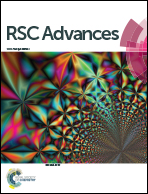Study of green epoxy resins derived from renewable cinnamic acid and dipentene: synthesis, curing and properties†
Abstract
An epoxy based on cinnamic acid (Cin-epoxy) and an anhydride curing agent based on dipentene were prepared. Both products are liquids of low viscosity at room temperature. For the synthesis of the epoxy, cinnamic acid was first converted to a diacid by reacting with maleic anhydride via Friedel–Crafts reaction, followed by allylation of the carboxylic groups and subsequent epoxidation of the allyl double bonds. The curing agent was the Diels–Alder adduct of dipentene and maleic anhydride (DPMA). The chemical structures of Cin-epoxy and DPMA were confirmed by 1H NMR, 13C NMR, FT-IR and ESI-MS. Non-isothermal curing of Cin-epoxy was studied using differential scanning calorimetry (DSC). In addition to DPMA, two commercial anhydrides were also used to cure Cin-epoxy and the curing reactivity and properties of cured resins were compared. Thermal mechanical properties and thermal stability of the cured epoxy resins were studied using dynamic mechanical analysis (DMA) and thermogravimetric analysis (TGA), respectively. Results showed that Cin-epoxy was slightly more reactive than the bisphenol A type epoxy DER 332 and displayed good dynamic mechanical properties and thermal stability.


 Please wait while we load your content...
Please wait while we load your content...